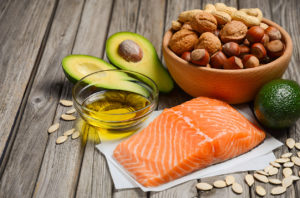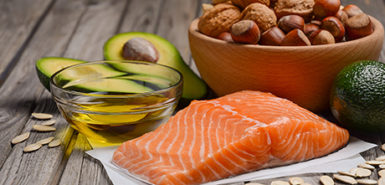
How much more dangerous is that strip of bacon compared to its Canadian counterpart? A fat calorie is a fat calorie, right? Wrong.
Although all fats have the same amount of calories per weight in grams (9 calories/gram to be exact), the impact they have on your heart health varies.
You may have heard about “good fats” versus “bad fats,” but what does that mean exactly? How does one define good?
A good fat is one that is considered to be beneficial to your health. For example, monounsaturated fats and omega-3 fatty acids are good fats. Saturated and trans fats are bad fats.
Monounsaturated fats and omega-3s are most often liquid at room temperature while saturated fats are most often solid at room temperature.
Think about how that translates to your body. A substance that is liquid can flow more freely through your bloodstream, while a substance that is of more solid consistency tends to get stuck during transportation.
When these heavy fats get stuck along your artery walls, plaque begins to develop. When plaque starts to develop along those artery walls, it narrows the passage for blood to flow through, thus requiring an increase in pressure to push that blood through a smaller vessel (think high blood pressure or hypertension).
Not only can a diet high in saturated and trans fats increase your bad cholesterol (LDL) levels, it can also indirectly increase your blood pressure by contributing to the formation of plaque on the arterial walls.
Trans fats are considered by some to be the worst of fats. They raise your LDL cholesterol and lower your good cholesterol (HDL). An increase in cholesterol and blood pressure puts you at greater risk of having a heart attack or stroke.
Good fats, like monounsaturated fats, actually help to raise your HDL and decrease your risk for heart attack or stroke as HDL helps transport bad fats away from your heart.
Common questions regarding healthy fats for your heart:
What are saturated fats?
This type of fat comes mainly from animal sources of food. Red meat, poultry, full-fat dairy products, cheese, sausage, bacon, mayo and butter, to name a few. Rule of thumb: If an item has 2 grams of saturated fat or more per serving, avoid it.
What about trans fats?
Most trans fats in the American diet come from products containing oils that are partially hydrogenated. These are found in many packaged baked goods (cakes, cookies, crackers), snack foods (potato chips, tortilla chips, microwave popcorn), fried foods, non-dairy coffee creamer and stick margarine.
If a food has any trans fats listed on the nutrition facts label, avoid it.
Do we need fat?
Yes. Fat supports a number of your body’s essential functions. Some vitamins need to have fat present in order to be absorbed and nourish your body.
Which fats should I be focusing on?
Monounsaturated fats: Studies show that eating foods rich in monounsaturated fats improves blood cholesterol levels, which can decrease your risk of heart disease. Think olive, peanut and canola oils, and nuts, seeds, peanut butter, avocado and fish.
Polyunsaturated fats: Evidence shows that eating foods rich in polyunsaturated fats improves blood cholesterol levels, which can decrease your risk of heart disease. Polyunsaturated fats may also help decrease the risk of type 2 diabetes. Soybean, corn and sunflower oils, and fish are excellent sources of polyunsaturated fats.
Omega-3 fatty acids: These fats appear to decrease the risk of coronary artery disease. They may also protect against irregular heartbeats and help lower blood pressure levels. There are plant sources of omega-3 fatty acids. However, the body doesn’t convert and use it as well as omega-3 from fish such as salmon, tuna, trout, mackerel and sardines. Plant sources of omega-3 fatty acids include flaxseed (ground), oils (canola, flaxseed, soybean), and nuts and other seeds (walnuts and sunflower).
Now that you know which types of dietary fat are healthy or unhealthy, and how much to include, how do you adjust your diet to meet dietary guidelines?
First, focus on reducing foods high in saturated fat, trans fat and cholesterol. Then emphasize food choices that include plenty of monounsaturated fats and polyunsaturated fats.
Although there are no established guidelines for the amount of healthy fats to consume, don’t go overboard. Remember, all fats, including the healthy ones, are high in calories. So consume foods rich in monounsaturated and polyunsaturated fats instead of other fatty foods, not in addition to them.
 /a>
/a>
 /a>
/a>
 /a>
/a>
Pretty good article. However, animal fat has also been found to contain trans fat – that also should be avoided…